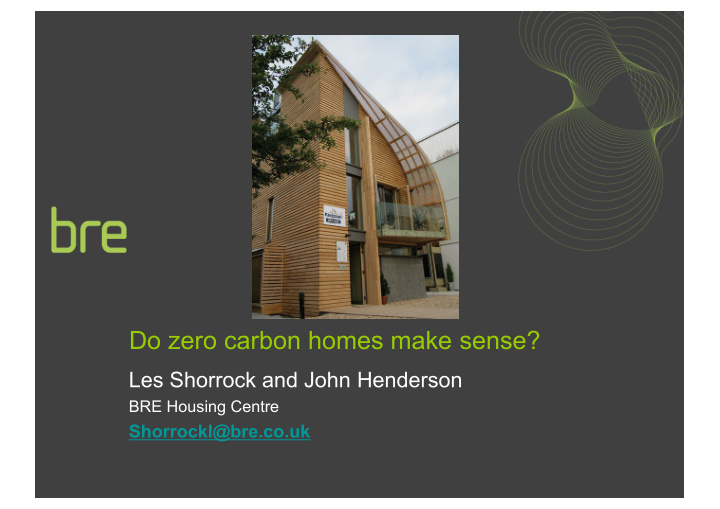



Do zero carbon homes make sense? Les Shorrock and John Henderson BRE Housing Centre Shorrockl@bre.co.uk
Background numbers – Carbon dioxide emissions from UK housing • In 2006 the UK housing stock accounted for 145.9 MtCO 2 (a little more than a quarter of the total UK emissions) • This is 5.5% lower than the emission in 1990 (154.4 MtCO 2 ) which is the reference point for the carbon dioxide reduction target for the year 2050. • By 2050, the aim is to have reduced carbon dioxide emissions by 80% relative to those in 1990 (meaning that we need to find savings of 123.5 MtCO 2 from housing by 2050)
The analysis undertaken 1. Previous work for the Office of Climate Change (now the Committee on Climate Change) examined the potential for carbon dioxide savings in the existing housing stock and the cost effectiveness of each measure. The results were presented in so-called cost- abatement charts (next slide). 2. Information on the costs and savings of different levels of the Code for Sustainable Homes was extracted from a study undertaken by the Department for Communities and Local Government. This was analysed in the same way. 3. The resulting two sets of figures were then combined to allow comparisons between savings from new and existing homes
Potential for cost-effective carbon dioxide emission savings from the existing housing stock
Carbon dioxide savings compared to the 2050 target • Potential cost-effective savings from improvements to existing homes amount to about 90 MtCO 2 relative to 2006 (98.5 MtCO 2 relative to 1990) • This falls short of the 123.5 MtCO 2 that is required. • New homes will simply add to the carbon dioxide emissions (i.e. they will reduce the 98.5 MtCO 2 saving) unless they are built to zero carbon standards. • Continuing to construct to the 2006 Building Regulations would add about 23 MtCO 2 by 2050 (assuming about 200,000 homes per year for 40 years – i.e. 8 million new homes). • So this argues that we need to introduce zero carbon homes at the earliest opportunity.
Anticipated timetable for zero carbon homes • Currently – 2006 Building Regulations apply • 2010 – level 3 of the Code for Sustainable Homes (25% better than 2006 Building Regulations) • 2013 – level 4 of the Code for Sustainable Homes (44% better than 2006 Building Regulations) • 2016 – level 6 of the Code for Sustainable Homes (zero carbon homes)
But are zero carbon homes cost-effective? (See the written paper for similar charts for each level of the Code)
Carbon dioxide emission reductions in 2050 and their cost effectiveness for new homes built to levels 1 to 6 of the Code for Sustainable Homes Code for Sustainable Homes NAC/tCO 2 MtCO 2 /yr level Level 1 -72.40 1.36 Level 2 79.21 2.45 Level 5 151.83 13.60 Level 3 211.13 3.40 Level 4 213.06 5.98 Level 6 213.67 23.19
Summary of table • Code level 5 appears more cost effective than Code levels 3 and 4 and has a much larger carbon dioxide saving. • Code level 6 (zero carbon) has very similar cost effectiveness to Code levels 3 and 4 and has an even larger carbon dioxide saving. • If carbon dioxide savings are of over-riding importance then the higher levels of the Code seem much more attractive (i.e. similar or better cost-effectiveness and much higher carbon dioxide savings).
But even level 6 will not meet the 2050 target
Conclusions - Do zero carbon homes make sense? • No (they are not cost-effective) • Yes (they are essential if we are to meet the 2050 target) • But much more needs to be done to meet the 2050 target – we must also decarbonise the supply of heat and electricity
Recommend
More recommend